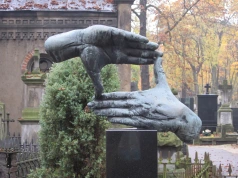• (1999) Penderecki: Cello Concerto no.2
Krzysztof Penderecki: Cello Concerto no.2
programme note written for
London Symphony Orchestra
London, 24 October 1999
Penderecki (b.1933) has been known since his student works of the late 1950s as a composer who is intensely interested in the nature of sound. His compositional search has taken him from experimental, ‘sonoristic’ works such as Threnody for the Victims of Hiroshima (1961) to the 19th-century imbued idioms of more recent pieces. Characteristic features of the 1960s period were the use of graphic notation and ad libitum sections, where coordination between players often took place only at junction points indicated by the conductor. Timbre was more significant than melody or thematic development, and registral extremes, glissandi, clusters, tremolos and percussive effects took pride of place. Sometimes, especially in his choral output, his expressionistic tendencies had extramusical dimensions, as in Dies Irae (1967), written to commemorate the tragedy of Auschwitz. Threnody, on the other hand, received its title after its composition, suggesting that it was originally intended as an abstract exploration of new string textures. Most of Penderecki’s orchestral output puts overt programmatic associations to one side, and this is especially true of the concertante works, where traditionally there is ample scope for musical rather than extramusical drama.
Penderecki’s earliest surviving concertante pieces are the Capriccio for oboe and strings and the Sonata for cello and orchestra, both completed in 1964 at the height of his sonic experimentation. Since then, Penderecki has composed a number of concertos, including two for violin (1976, 1995), a Viola Concerto (1983) and a Flute Concerto (1992). His interest in the cello was stimulated by several collaborations with Siegfried Palm, who premiered the First Cello Concerto at the Edinburgh Festival in 1972, and by Mstislav Rostropovich, who gave the first performance of the Second Cello Concerto in Berlin on 11 January, 1983.
As in the earlier two-movement Sonata and the single movement First Cello Concerto, Penderecki bypasses conventional concerto form in the Second Cello Concerto. There is no semblance of the traditional three-movement, fast-slow-fast pattern. Instead, he creates an alternation between slow and fast sections, each appearing three times, followed by a coda in slow tempo. The slow sections are all introduced by a distant, simplified relative of Penderecki’s block textures with glissandi. Here, it consists of quietly reiterated quavers in the upper strings which include shallow glissandi. The initial B natural is counterpointed shortly by a low F natural, the resulting tritone setting a tone of uncertainty, even of imminent cataclysm (note the tolling bells), which the concerto proceeds to exploit. A second theme appears, on low strings, in which a chain of tritones and semitones (Penderecki’s idée fixe for many years) yearns upwards towards a pair of minor thirds, which become important later on. The soloist appears only towards the end of this opening part of the concerto.
The first fast section ensues, full of brief phrases and hesitant repartee, as if we have been launched immediately into a development section. After a purely orchestral climax, there is a short section for unpitched percussion and soloist (with minor thirds prominent), before an extended return to the slow material. Now it is the soloist who takes the lyrical lead, intensifying the tone of melancholy. When the second fast section appears, it is initiated by the unpitched percussion and cello thirds, as if picking up the argument regardless of the intervening slow music, but this is all part and parcel of Penderecki’s process of overlapping developmental structures. This is the most goal-directed section in the concerto, with a strong sense of coordinated rhythmic momentum.
The third slow section in turn builds on the second, becoming a dark and dramatic accompanied recitative with moments of great tenderness. It also includes examples of latter-day ad libitum passages. The final fast section revisits the percussion/minor third combination before exploring its material in a series of seven fast-moving variations (more apparent perhaps on paper than aurally given the work’s consistently developmental character). A brief recall of the opening slow material concludes this rather introspective score. Its obsessive motivic ideas, stark musical contrasts and nervous energy make for one of Penderecki’s most compelling works.
© 1999 Adrian Thomas
☚
PROG NOTES
(repertoire list)
